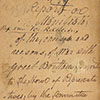
Students will examine primary sources from the historical records of Congress to analyze the reasons in support of and opposed to going to war against Great Britain in 1812. They will compare multiple perspectives to assess various rationales for whether to fight the War. Reflecting upon their evaluations, students will consider what is worth fighting for and who, under the constitutional separation of powers, should decide questions of war. The document studies conducted in Activities 3 and 5 are based on Common Core State Standards.
In 1812, members of Congress confronted complex issues when faced with the decision of whether to declare war for the first time under the Constitution. Examining the viewpoints of several actors in that decision, including the President, a congressional committee, and concerned citizens, allows students to gain an understanding of why and how a republic decides to fight a war. This understanding will shed light on other historical declarations of war or decisions to commit troops to combat. It also provides students with the tools to participate as a citizen in the nation’s future decisions on war.
Why and how did Congress declare war in 1812?
U.S. History; U.S. Government; Civics
War of 1812, war, declarations of war, separation of powers, Constitution, Article I, Article II, Common Core, informational texts, primary sources
The time needed to complete each learning activity is presented in parentheses at each step. The activities can be done in sequence or each can be done separately.

House Foreign Relations Committee Report on the War of 1812, the "War Manifesto"; June 3, 1812; RG 233, Records of the U.S. House of Representatives.
View in National Archives Catalog
1. Why and How Should America Go to War? (15 minutes)
Divide the students into small groups to address and discuss the questions and Venn diagrams on Worksheet 1. Instruct each group to select a spokesperson to report their discussion to the class.
2. The Founders and War: Constitutional Context for Declaring War (15 minutes)
Divide the students into small groups to discuss the excerpts from the Constitution on Worksheet 2, and answer the questions. Direct each group to report back to the class, and then engage the full class in a discussion of the questions.
3. Document Study: President James Madison’s Third Annual Message to Congress, November 5, 1811 (30 minutes)
Divide the students into small groups to answer the questions on Worksheet 3 about an excerpt from President James Madison’s Third Annual Message to Congress, which is available as Handout 1. Direct each group report back to the class, then, engage the full class in a discussion of the questions. The questions on Worksheet 3 are aligned with the Common Core State Standards for reading informational texts.
4. Congressional Debate on Declaring War in 1812 (30 minutes)
Divide the class into five small groups to discuss quotes from congressional debate related to declaring war in 1812. Assign one quote from Handout 2 to each group. For each quote students should answer:
On the board, draw a continuum with one end marked as Pro-War and the other marked Anti-War. Direct each group to mark on the continuum where they believe their quote falls, and to cite evidence from the quote to support their determination. Lead a class discussion on these questions:
5. Document Study: The "War Manifesto,"; House Foreign Relations Committee Report on a Declaration of War, June 3, 1812 (30 minutes)
Divide the students into small groups to answer the questions on Worksheet 4 about an excerpt from the "War Manifesto," House Foreign Relations Committee Report on a Declaration of War, which is available as Handout 3. You may also choose to distribute or project a facsimile of the Report. Direct each group to report back to the class, then engage the full class in a discussion of the questions. The questions on Worksheet 4 are aligned with the Common Core State Standards for reading informational texts.
6. Reflection Questions: The War of 1812 and the Role of Congress in Decisions about War (30 minutes)
Draw upon the insights gained in discussing how and why the U.S. declared war in 1812 to consider the following questions that are applicable to the decisions made later to enter other wars as well as future decisions about war.
Related Resources from the National Archives:
President James Madison’s Third Annual Message to Congress, November 5, 1811
View in the National Archive Catalog: 7347265
Declaration of War with Great Britain, War of 1812, June 18, 1812
View in the National Archive Catalog: 299950
Treaty of Peace and Amity Between the United States and Great Britain (Treaty of Ghent),
December 24, 1814
View in the National Archive Catalog: 5730368
If you have problems viewing this page, please contact legislative.archives@nara.gov
This page was last reviewed on October 10, 2020.
Contact us with questions or comments.